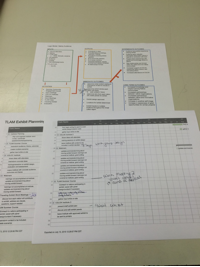
This week the TLAM summer engagement course made huge progress of creating a draft project plan for the traveling exhibit. The plan will be shared with a group from the Wisconsin Historical Society, CGLCK Advisory Board, and eventually the whole group in October. I was really looking forward to it because I finally felt like we were moving forward to put together several of the topics we had been bouncing around in class.
Reflecting on the two days we worked on the plan, all I can say is, it was a lot harder than I thought it would be! Since we each of us came to class with a draft plan, I figured we could just pull our ideas together, obviously talking over some things more than others, but I really felt like we were ready to get the plan down. Let’s just say, expectations needed to be adjusted a little and I had to remind myself to be patient.
This is a big project, with lots of little details that one person can easily forget about, and it was apparent how important it was to go over the plan as a small group, because there were aspects of the project that I hadn’t thought about, or details we went into a lot more depth than I thought necessary originally. We were all approaching the planning process from different backgrounds, mindsets, and experiences, and we each saw certain aspects of the project as more important than others. This was a very good learning opportunity for me, especially in relation to understanding how to work through projects with a consensus process. The “we need to get this done now or the world is going to end” feeling I was experiencing “is contradictory to creating space for sharing and learning in process and that by slowing down, although really hard for me to do, helped me gain a better understanding of listening and creating a group consensus that respects our differences and interconnections.
It was also a good practice of accretive thinking, circling back to the same topics, to create/build knowledge together. I was aware of it most for how we talked about each activity. With further reflection, I feel accretive thinking applies to exhibit planning principles in general; you always should come back to the objectives and outcomes of the project, ensuring that everything you are doing is meeting those goals.
This project is all about collaboration, bringing people together to create a unique, impactful traveling exhibit and this past week project planning helped prepare us to move forward. We shared the draft plan with a team from the Wisconsin Historical Society, and they affirmed that we were on the right track with the plan. With a few tweaks and added suggestions from them, the draft will be ready to share with the Advisory Board in August who will bring more perspectives, ideas, and expertise to the process. It will be exciting to see what directions the Culture Keepers choose for the exhibit as they develop the project.
-Claire Parrish
